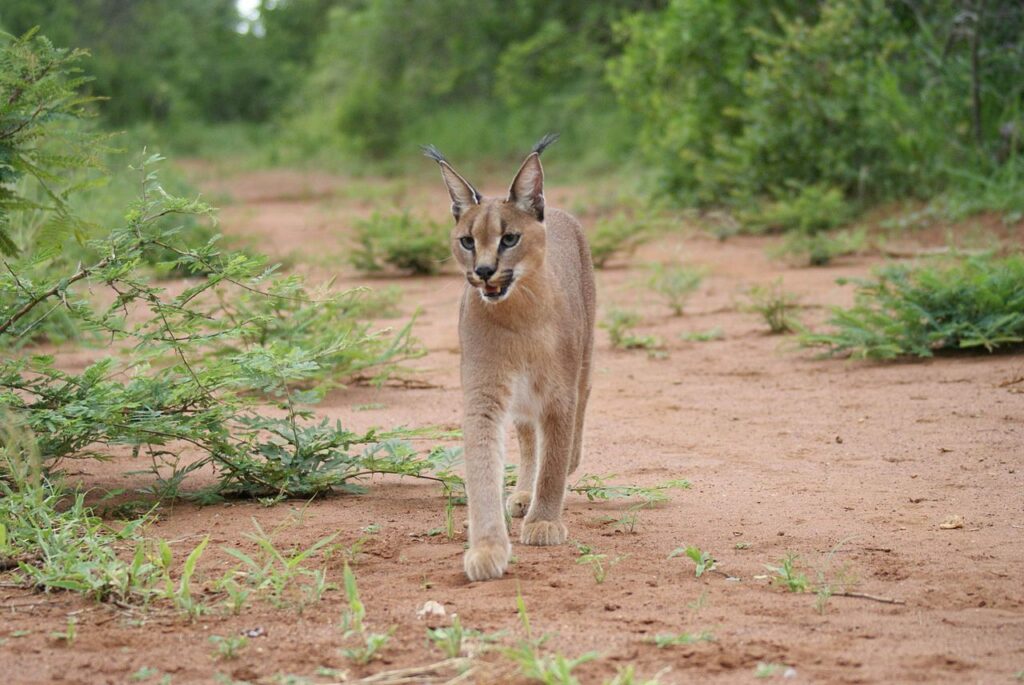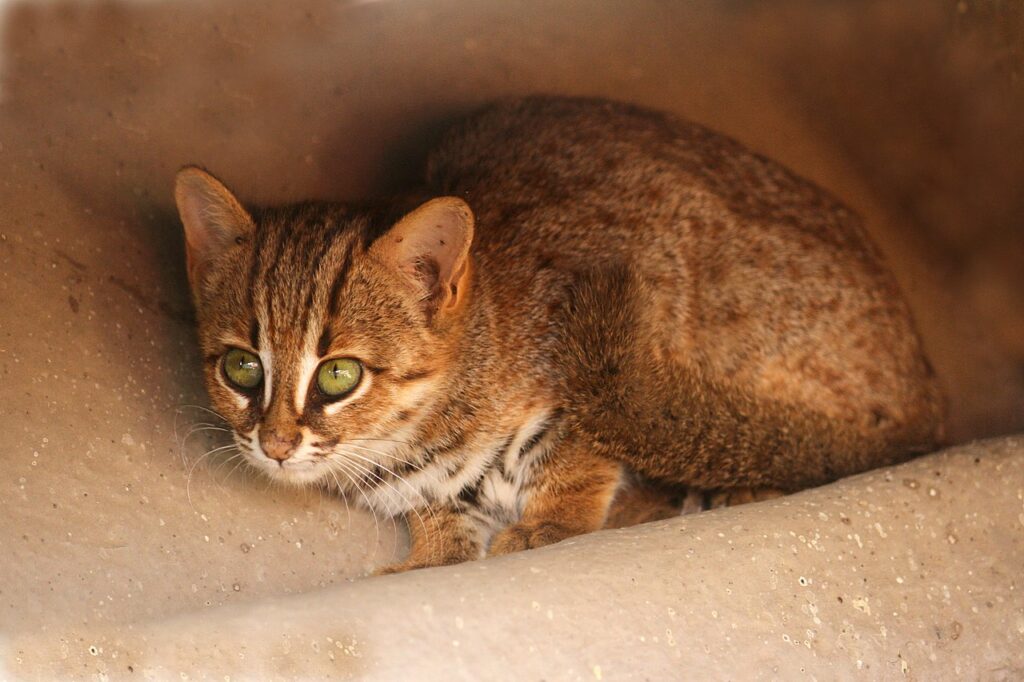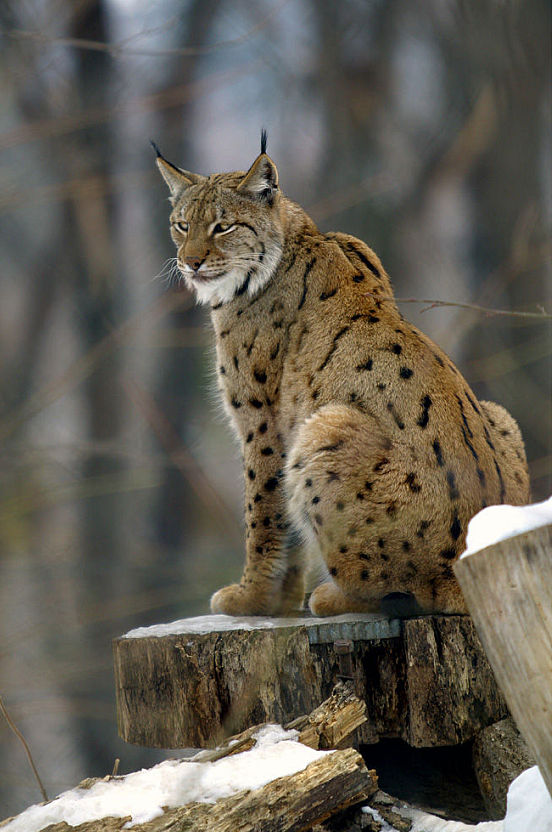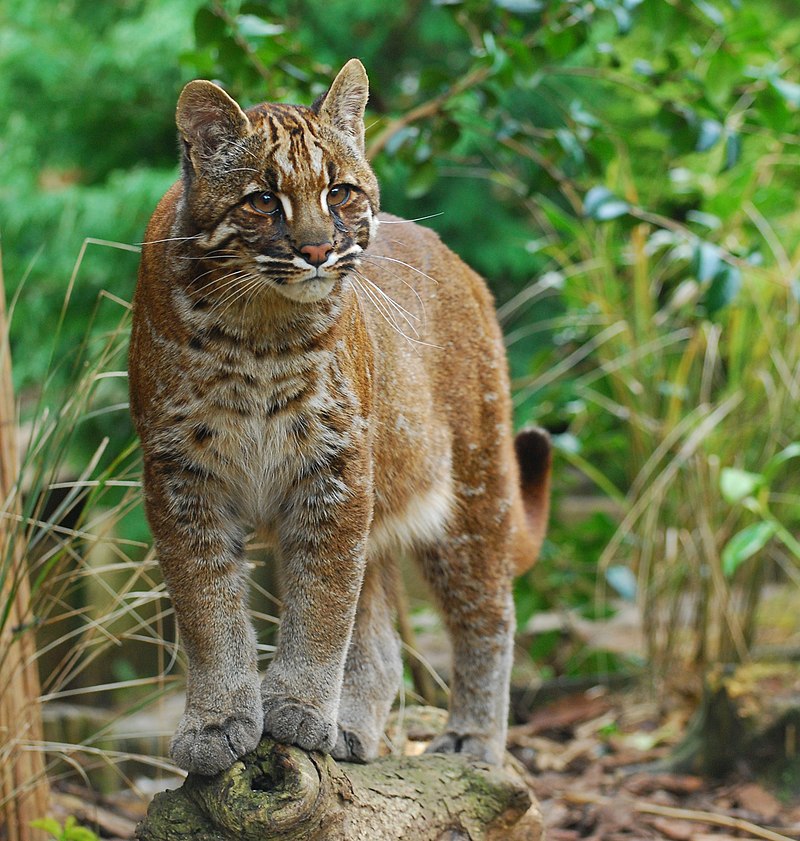India is a land of diverse wildlife and the home to some of the most magnificent and unique animal species. India has at least 15 species of wild felines which is the highest in the world and they differ in size, habitat, diet and body shape. Let us explore and learn about India’s wild felines. We will start with the lesser known species.
1. Asiatic Caracal
Incredibly rare in India, there is no definite idea about the population but whatever research has been done on them gives us evidence that very few remain in India. Being shy and elusive, very little photographic evidence exists. The body is slender and long, with golden fur and black tuft of hair in the top of rather large ears. This species of wild cat is probably in most need of conservation.Photo by N. Shiva Kumar, Mongabay India.

Diet- Rodents like Hares, Birds, Reptiles, and even young ones of gazelles.
Status- Critically Endangered in India
Habitat- Dry and shrublands, grasslands and semi-desert habitat.
Distribution- In India, their presence from photographic evidence has only been recorded in the states of Rajasthan, Gujarat and Madhya Pradesh.
Threats- Habitat loss, Lack of research and knowledge.
2. Rusty Spotted Cat
Termed as the ‘smallest wild cat in the world’, Rusty spotted cats are truly a bundle of cuteness. The coat is rusty with spots that help them to camouflage with the fallen leaves and the forest litter. Like most other wild cats, they are also nocturnal in nature.

Diet- Rodents, Birds, Lizards, Frogs and large insects.
IUCN Status- Near Threatened.
Habitat- Prefer deciduous forest with dense vegetation and rocky area.
Distribution- In India, they have a big range. They are mostly observed in Southern and Central Indian states but have been sighted in Northern states of Haryana and Uttar Pradesh as well.
Threats- Habitat loss & Spread of cultivation, occasionally hunted for food or as livestock pests.
Pallas’ Cat
Given the title of the ‘grumpiest cat in the world’ due to its look, Palla’s cat is a small sized cat with heavy and dense grey coloured fur. They are adapted to life in cold snowy mountainous regions.
Diet- Voles, Pikas, Lizards and Birds.
IUCN Status- Least Concern
Habitat- Mountainous and snowy terrain.
Distribution- In India, it is found in Ladakh, Sikkim and Uttarakhand.
Threats- Habitat fragmentation, habitat loss, feral dogs and poaching.
4. Eurasian Lynx.
One of the rarest cats inside India’s boundaries, the Eurasian Lynx is quite difficult to spot due to its elusive and crepuscular nature. Adapted to colder environments, these middle-sized cats have a thick brownish or pale greyish coat along with distinctive black ear tufts and a small tail. They are known for burying their prey and eating it for the next few days.

Diet- Hares, Boars and small ungulates like goats.
IUCN Status- Least Concern
Habitat- Mountainous and snowy terrain.
Distribution- In India, it has been sighted in Ladakh, Sikkim and Himachal Pradesh
Threats- Habitat loss and fragmentation, poaching and depletion of prey base.
5. Fishing Cat
Larger than any other small cat, the fishing cat is the only feline which has adapted to a life in water. Short legs, deep chest and short stubby tail differ them from other feline species. Their body is brownish with light spots which perfectly camouflage in the muddy water of mangroves. They dive their head first, catching the fish off guard and then bringing it off shore where they enjoy their meal. They are primarily nocturnal.
Diet- Majorly fishes, other aquatic animals and waterbirds.
IUCN Status- Vulnerable
Habitat- Mangroves and wetlands
Distribution- In India, its range includes the states of West Bengal, Orissa and Andhra Pradesh
Threats- Habitat loss, pollution of water bodies and overexploitation of natural fish stock.
6. Marbled Cat
Named after the beautiful and distinctive marbling pattern on their brownish coat, Marbled cats are small sized felines who are arboreal in nature i.e. they are adapted to life on trees. They have well rounded ears and a cylindrical tail as long as their body which helps in counterbalancing. Being incredibly shy and elusive, these felines are hard to observe, thus not a lot is known about them.
Diet- Squirrels, Fruit bats, Birds and Rodents.
IUCN Status- Near Threatened.
Habitat- Foothills of Himalayas, in the evergreen and moist deciduous forests.
Distribution- Forest of the North-eastern states.
Threats- Deforestation, indiscriminate snaring and poaching.
7. Clouded Leopard
They have large dusky-grey blotches and irregular spots and stripes reminiscent of clouds giving them the name of ‘Clouded Leopard.’ Of any feline in the world, they have the largest canine to body ratio. Even though they are arboreal in nature, most of the hunts take place in the forest floor. Tail is long to support tree climbing and to maintain balance. Like most other felines, they are also nocturnal.
Diet- Birds,monkeys, and small deer species like the barking deer and the hog deer.
IUCN Status- Vulnerable.
Habitat- Foothills of Himalayas, in the evergreen and moist deciduous forests.
Distribution- Forest of the North-eastern states.
Threats- Deforestation, habitat fragmentation and poaching.
8. Leopard Cat
Around the size of a domestic cat but more slender, the leopard cats have a wide variety of colour coats and coat markings. Two subspecies can be so different from each other in looks that one may think of it as two completely different species. The subspecies found in India has a pale silver grey coat with black spots or rosettes. They are the most widely found small cat in the continent of Asia.
Diet- Small rodents like mice and shrew, birds and small reptiles.
IUCN Status- Least Concern.
Habitat- Highly adaptable. Can be found in subtropical deciduous and coniferous forests as well as in agricultural plantations.
Distribution- Two different populations are said to exist in India; one in north and north-eastern part and other in western ghats.
Threats- Hunting and poaching.
9. Asian Golden Cat
This middle sized cat is one of the most courageous hunters of all the wild felines. They are known to take down prey bigger than their size. They show polymorphism that is they occur in different morphs or coat colours. Golden, reddish brown and buff brown individuals have been recorded along with incredibly rare melanistic coats.

Diet- Larger rodents, birds, reptiles and small ungulates
IUCN Status- Near Threatened.
Habitat- Inhabits deciduous, tropical and subtropical forests.
Distribution- North- Eastern states of India.
Threats- Habitat destruction, deforestation, reduction in prey base.
10. Asiatic Wild Cat / Indian Desert Cat
Similar to domestic cats in size, the coat of an Indian desert cat is sandy brown with distinct black spots on the back of its body. The legs are slender and the tail is long, tapering with a short black tip. The coat is rather thin due to adaptability to a warmer climate.
Diet- Desert gerbils, hares, birds, reptiles and eggs of ground birds.
IUCN Status- Not much information but the population is thought to be declining.
Habitat- Shrublands, desert and semi desert regions.
Distribution- Common in the desert and semi-desert region of Rajasthan, have also been sighted in Madhya Pradesh and Uttar Pradesh.
Threats- Hybridisation with domestic cats, revenge killing for poultry.
11. Jungle Cat
This medium sized cat has a uniformly sandy, reddish-brown or grey fur without spots. They show sexual dimorphism, females are smaller and lighter than males. Rare melanistic and albino individuals have also been spotted. Thickness of fur changes according to the weather. Tail ends with a black tip. One thing that differentiate it from other cats is that this cat shows an omnivorous diet. They have been observed eating fruits in the winter season. They are typically diurnal.
Diet- Mainly rodents, Hares, birds, reptiles and frogs, occasionally fruits.
IUCN Status- Least Concern.
Habitat- Swamps, wetlands,littoral areas, grasslands and shrublands, can often be sighted near human settlement.
Distribution- Most common small wild cat of India.
Threats- Habitat loss, revenge killing for poultry.
12. Snow Leopard
Called the ‘Ghost of the mountains’, Snow leopards have whitish to greyish fur with black spots on head and neck, with larger rosettes on the back, flanks and bushy tail. The belly is white. Extremities are small to reduce escape of body heat in cold climates. It differs from other felines by a shorter mussel and an elevated forehead. Backside of the paws are also covered from fur aiding grip in uneven mountain terrain.
Diet- Marmots, Himalayan Blue sheep, Himalayan Tahr and wild goats.
Status- Critically Endangered in India.
Habitat- Snowy mountain range of the Himalayas.
Distribution- Jammu & Kashmir, Ladakh, Uttrakhand, Himachal Pradesh, Sikkim and Arunachal Pradesh.
Threats- Shrinking habitat, Global warming, poaching and illegal trade.
13. Asiatic Lion
Everybody knows about lions but maybe a few may not know that they are found in India too! Asiatic lions are found only in India in the entire world. The fur colour is golden-brown. Sexual dimorphism is seen as only the males have manes. Unlike their African cousins, the manes are quite sparse. Other distinctive differences are the presence of a larger tail tuft and skin fold on the abdomen. Lions are the most social of big cats, Asiatic male may form a loose pride with up to three females. Unfortunately, politics is hindering the conservation of Gir’s Lions.
Diet- Chital, Sambar deer, Nilgai and livestock.
IUCN Status- Endangered.
Habitat- Dry deciduous forests, scrublands and grasslands.
Distribution- Currently only home is Gir WS in Gujarat.
Threats- Small gene pool, inbreeding and heavy concentration in only one area risks to wiping out of the species in case of any epidemic
14. Indian Leopard
Most widely found species of big cat in India, the Indian leopard has it all to succeed in most of the habitats. They are extremely adaptable, with many living around human settlements. Body is yellow in colour, the belly region is white and the whole body is marked with black rosettes. They are mostly nocturnal and live solitary lives. They are well known to carry their prey to a tree branch where it is protected from other predators.
Diet- They are fairly adaptable and prey on a variety of species. Common prey are Chital, Sambar and livestock.
IUCN Status- Vulnerable.
Habitat- Evergreen forests, Moist and dry deciduous and semi-arid regions.
Distribution- Found in most of India except high altitude.
Threats- Habitat loss, human-animal conflict, poaching and road accidents.
15. Royal Bengal Tiger
The most famous and well known cat of India is the Tiger. The body coat is yellow to light orange which is covered in black strips. The pattern of these stripes differ from tiger to tiger. They are the apex predator in most of the Indian forests. They prefer to live alone, mother raises the cubs by herself. Once they were near extinction but conservation efforts by the Indian government has ensured a healthy and sizable population in India.
Diet- Deers, Nilgai, Monkeys and subadult Gaurs.
IUCN Status– Endangered.
Habitat- Evergreen and Deciduous forests
Distribution- Widely distributed in India, found in most of the states.
Threats- Habitat loss, Human-tiger conflict and poaching
Apart from these 15 cats, India do have the common domestic cat and now cheetahs have also been controversally reintroduced.
Help us Help Them! Think Wildlife Foundation is a non profit organization with various conservation initiatives. Our most prominent campaign is our Caring for Pari intiative. Pari is a rehabilitated elephant at the Wildlife SoS Hospital. 25% of the profits from our store are donated to the elephant hospital for Pari. Other than buying our wonderful merchandise, you could donate directly to our Caring For Pari fundraiser.
Written by: Samarth Jain
